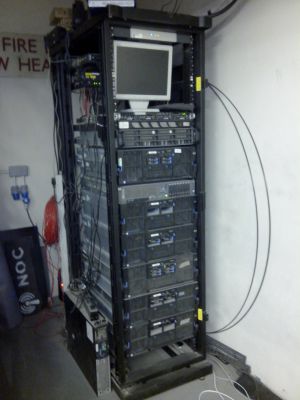Archive:Equipment/Borg
| Line 150: | Line 150: | ||
* realtime ray-tracing | * realtime ray-tracing | ||
* Radio FFT decoding in real-time (Cubesat related) | * Radio FFT decoding in real-time (Cubesat related) | ||
| − | |||
| − | |||
| − | |||
| − | |||
| − | |||
| − | |||
| − | |||
| − | |||
| − | |||
| − | |||
| − | |||
| − | |||
Revision as of 17:26, 6 May 2015
| Borg | |
|---|---|
 | |
| Model | IBM 3950 M2 |
| Sub-category | Systems |
| Status | Under Construction |
| Accessories | Bits |
| Training requirement | yes |
| ACnode | no |
| Owner | Hackspace |
| Origin | Donation |
| Location | Basement rack |
| Maintainers | Oni, Tgreer |
Borg is a virtual host server to be used to give members access to virtual machines in the space and ultimately replace many if not all the functions of Babbage.
Naming
We are naming this machine after Anita Borg. Also the Borg.
They're currently labeled as BORG1 through BORG6 from bottom to top.
Access
Currently connected to the SPC1601 PDU, we need a better way of adding accounts.
Specs
IBM 3950 M2
- 16 cores total
- 4 x Xeon 7330: 4 cores @ 2.4 GHz "Tigerton" Intel Ark spec sheet
- 128 GB ram
BORG1 - 3 CPUs, 8GB RAMBORG2 - 3 CPUs, 8GB RAM- BORG3 - 4 CPUs, 128GB RAM - has bios A3E170AUS-1.16
- BORG4 - 4 CPUs, 128GB RAM
- BORG5 - 4 CPUs, 128GB RAM
- BORG6 - 3 CPUs, 128GB RAM
IP
172.31.24.11
RAS
The RAS II is a separate control system that is setup in the bios and accessible as soon as a BORG unit has power (i.e, if the green light is flashing OR solid). Using a web browser head to either
- Borg3 http://172.31.24.170
- Borg5 http://172.31.24.171
Username USERID password PASSW0RD
BIOS
With dmidecode
* Borg3 Version A3E170AUS-1.16 * Borg5 Version 1.16
ScaleXpandr
In order to link upto 4 borgs together we need to use the special cables. http://www.redbooks.ibm.com/redbooks/pdfs/sg247630.pdf - page 235 shows how this is done to create an SMP style set of nodes.
Logbook
Running Debian
- Needs the non-free bnx2 firmware on a flash drive for the install to work, (could try to add it to the install initrd)
- Something something IBM Calgary IOMMU something something leads to DMA errors and the LSI MegaRaid raid card dosn't work, booting with "iommu=soft" makes it work but may not be ideal. search https://www.kernel.org/doc/Documentation/x86/x86_64/boot-options.txt for iommu
- The incantation seems to be: iommu=soft,calgary megaraid_sas.msix_disable=1
Upgrading the bios
Do a diskless boot, the go do Debian and then "Jessie amd64 Diskless for BORGs", log in as root (password 'root', this diskless setup is for testing only!), then:
cd ibm-bios/z/ ./lflash64
This is an upgrade to bios version 1.16
We also need to upgrade:
The RSA II thing: https://www-947.ibm.com/support/entry/portal/docdisplay?lndocid=MIGR-5086633 The FPGA (in the scaleXpander?) The BMC
We might be able to do it individually, or perhaps use the IBM UpdateXpress thing, which needs SUSE Linux Enterprise Server 11 x86-64 or Red Hat Enterprise Linux 6 x86-64.
We need to reset all the bios etc settings to there defaults.
link dump
- https://bugs.launchpad.net/ubuntu/+source/linux/+bug/343749
- http://www-947.ibm.com/support/entry/portal/docdisplay?lndocid=migr-5083138
- http://dump.asiantuntijakaveri.fi/le_bueno_dumpo/lsi/
- https://wiki.debian.org/LinuxRaidForAdmins
- http://hwraid.le-vert.net/wiki/DebianPackages
good megaraid cli guide:
- http://hwraid.le-vert.net/wiki/LSIMegaRAIDSAS
- http://www.linuxsa.org.au/pipermail/linuxsa/2011-November/094772.html
reflashing?!?:
Birth
It is reasonable to say the birth of Borg has been long and difficult, concern has generally revolved around the 3 areas:
- Usage
- Energy Consumption
- Location
Each have been discussed on the mailing list but for summary.
Usage
Energy Consumption
Recent tests comparing Borg3 with AWS , rendering 30 Frames of a small Blender Scene with Blender 2.76 and maxing out the processors:
AWS
- $0.520 per On Demand Linux c1.xlarge Instance Hour at 12 hours
- Cost is roughly £4.60 at current exchange
- Spot instances are possible with Brenda or similar - at $0.07 the cost would be roughly 53p
Borg3
- £0.12p per Kilowatt Hour
- With all 16 Cores operating at 100% Borg was drawing 560Watts
- To render the same scene took 206minutes
- Total Cost 23p
The main issue of course - is it worth spending the time linking them all or just keeping one with some method of spinning it up and down?
Borg (being a server) could add substantially to our electricity costs. To help this we can offset some of it by the retiring of other machines in the space. It has also been agreed that if it takes up more than 275W regularly then a decision about Borgs future will have to be made. If it goes over 300W we will have to re-think our strategy. These figures are a maximum and equate to about £27 per month in electricity costs. The power consumption will be regularly measured and anyone is welcome to report power consumption levels.
Location
The Rack in the basement.
Potential uses
- Rendering video and 3D
- Bio-informatics number crunching (bio-hackers?)
- simulation
- realtime ray-tracing
- Radio FFT decoding in real-time (Cubesat related)
Showing 2 related entities.